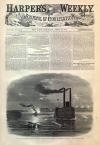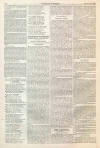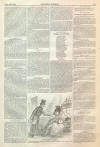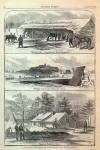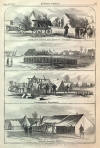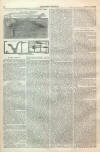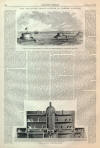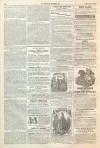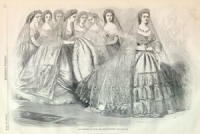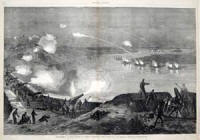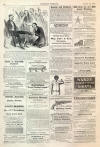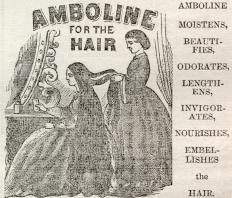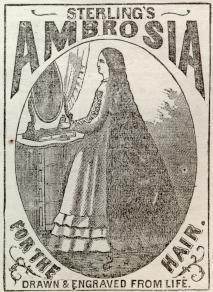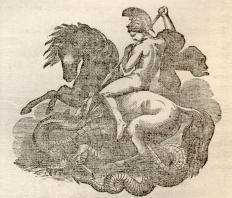Battle of Port Hudson
|
|
This Site:
|
HARPER'S WEEKLY. [APRIL 18, 1863. 254 THE FIGHT AT PORT HUDSON.ON the night of 14-15th March Admiral Farragut passed the rebel batteries at Port Hudson with his flag-ship, the Hartford, and the Albatross. He attacked the forts with his entire fleet, but all but the two vessels above named were repulsed, and the Mississippi, having grounded, was set on fire and abandoned. We illustrate the combat on pages 248 and 249, and subjoin the following condensed account of the affair from the Herald correspondence: THE REBEL BATTERIES.The rebel batteries extend about four miles in length, with a gap here and there between. Below, just before the high bluff begins, a very large number of field batteries were placed in position. These batteries are by no means to be despised; for in such a narrow part of the river they are just as effective as siege guns, especially as they can be handled with far greater facility than ordnance of larger size. Proceeding upward, the regular fortifications commence. They seem to consist of three distinct ranges of batteries, numbering several in each range. It does not seem, however, that either of them mounts guns of very large calibre. The river now begins to trend to the west, forming a faint representation of a horseshoe, in the hollow of which the town of Port Hudson is situated. It is right in that hollow, and just below the town, that the most formidable battery—the central one—is situated, on the highest bluff. Four heavy guns appear to be mounted there in casemates. I say appear, because the flashes from these guns revealed nothing; but the flame from the muzzles showed that all beyond was in obscurity —precisely as would be the case with guns in casemate. The other guns, en barbette, or peering through open embrasures, revealed, when fired, something of the lay of the land behind and around, though but for a moment. Above the town are other batteries, only less formidable than those just below. Beyond these the high bluffs gradually subside into the general level of the surrounding country. Right opposite the principal batteries, on the right bank of the river, is the point of land on which the Mississippi grounded, in consequence of which she had to be set on fire and destroyed. After describing the first shots from the Hartford, which were promptly returned from the rebel batteries, the correspondent thus describes the MORTARS OPENING FIRE.And now was heard a thundering roar, equal in volume to a whole park of artillery. This was followed by a rushing sound, accompanied by a howling noise that beggars description. Again and again was the sound repeated, till the vast expanse of heaven rang with the awful minstrelsy. It was apparent that the mortar-boats had opened fire. Of this I was soon convinced on casting my eyes aloft. Never shall I forget the sight that then met my astonished vision. Shooting upward at an angle of forty-five degrees, with the rapidity of lightning, small globes of golden flame were seen sailing through the pure ether—not a steady, unfading flame, but corruscating, like the fitful gleam of a fire-fly—now visible, and anon invisible. Like a flying star of the sixth magnitude, the terrible missile—a 13-inch shell—nears its zenith, up and still up—higher and higher. Its flight now becomes much slower, till, on reaching its utmost altitude, its centrifugal force becomes counteracted by the earth's attraction; it describes a parabolic curve, and down, down, it comes, bursting, it may be, ere it reaches terra firma, but probably alighting in the rebel works ere it explodes, where it scatters death and destruction around. THE "RICHMOND" AT WORK.The Richmond had by this time got within range of the rebel field batteries, which opened fire on her. I had all along thought that we would open fire from our bow guns, on she topgallant forecastle, and that, after discharging a few broadsides from the starboard side, the action would be wound up by a parting compliment from our stern chasers. To my surprise, however, we opened at once from our broadside guns. The effect was startling, as the sound was unexpected; but beyond this I really experienced no inconvenience from the concussion. There was nothing unpleasant to the ear, and the jar to the ship was really quite unappreciable. It may interest the uninitiated to be informed how a broadside is fired from a vessel-of-war. I was told on board the Richmond that all the guns were sometimes fired off simultaneously, though it is not a very usual course, as it strains the ship. Last night the broadsides were fired by commencing at the forward gun, and firing all the rest off in rapid succession, as fast almost as the ticking of a watch. The effect was grand and terrific; and, if the guns were rightly pointed—a difficult thing in the dark, by-the-way—they could not fail in carrying death and destruction among the enemy. Of course we did not have every thing our own way; for the enemy poured in his shot and shell as thick as hail. Over, ahead, astern, all around us, flew the death-dealing missiles, the hissing, screaming, whistling, shrieking, and howling of which rivaled Pandemonium. It must not be supposed, however, that because our broadside guns were the tools we principally worked with, our bow and stern chasers were idle. We soon opened with our bow 80-pounder Dahlgren, which was followed up not long after by the guns astern, giving evidence to the fact that we had passed some of the batteries. THE ACTION BECOMES GENERAL.Soon after firing was heard astern of us, and it was soon ascertained that the Monongahela, with her consort, the Kineo, and the Mississippi, were in action. The Monongahela carries a couple of two hundred-pounder rifled Parrott guns, besides other ticklers. At first I credited the roar of her amiable two hundred-pounders to the "bummers," till I was undeceived, when I recalled my experience in front of Yorktown last spring, and the opening of fire from similar guns from Wormley's creek. All I can say is, the noise was splendid. The action now became general. The roar of cannon was incessant, and the flashes from the guns, together with the flight of the shells from the mortar boats, made up a combination of sound and sight impossible to describe. To add to the horrors of the night, while it contributed toward the enhancement of a certain terrible beauty, dense clouds of smoke began to envelop the river, shutting out from view the several vessels and confounding them with the batteries. It was very difficult to know how to steer to prevent running ashore, perhaps right under a rebel battery or into a consort. Upward and upward rolled the smoke, shutting out of view the beautiful stars and obscuring the vision on every side. Then it was that the order was passed, "Boys, don't fire till you see the flash from the enemy's guns." That was our only guide through the "palpable obscurity." Intermingled with the boom of the cannonade arose the cries of the wounded and the shouts of their friends, suggesting that they should be taken below for treatment. So thick was the smoke that we had to cease firing several times, and, to add to the horrors of the night, it was next to impossible to tell whether we were running into the Hartford or going ashore, and, if the latter, on which bank, or whether some of the other vessels were about to run into us or into each other. All this time the fire was kept up on both sides incessantly. It seems, however, that we succeeded in silencing the lower batteries of field-pieces. MUZZLE TO MUZZLE.This phrase is familiar to most persons who have read accounts of sea-fights that took place about fifty years ago; but it is difficult for the uninitiated to realize all the horrors conveyed in these three words. For the first time I had, last night, an opportunity of knowing what the phrase really meant. The central battery is situated about the middle of the segment of a circle I have already compared to a horseshoe in shape, though it may be better understood by the term "crescent." This battery stands on a bluff so high that a vessel in passing immediately underneath can not elevate her guns sufficiently to reach those on the battery; neither can the guns on the battery be sufficiently depressed to bear on the passing ship. In this position the rebel batteries on the two horns of the crescent can enfilade the passing vessel, pouring in a terrible crossfire, which the vessel can return, though at a great disadvantage, from her bow and stern chasers. We fully realized this last night; for, as we got within short range, the enemy poured into us a terrible fire of grape and canister, which we were not slow to return—our guns being double-shotted, each with a stand of both grape and canister. Every vessel in its turn was exposed to the same fiery ordeal on nearing the centre battery, and right promptly did their gallant tars return the compliment. This was the hottest part of the engagement. We were literally muzzle to muzzle, the distance between us and the enemy's guns being not more than twenty yards, though to me it seemed to be only as many feet. In fact, the battle of Port Hudson has been pronounced by officers and seamen who were engaged in it, and who were present at the passage of Fort St. Philip and Fort Jackson, below New Orleans, and had participated in the fights of Fort Donelson, Fort Henry, Island No. 10, Vicksburg, etc., as the severest in the naval history of the present war. THE "RICHMOND" RETURNS.Matters had gone on in this way for nearly an hour and a half—the first gun having been fired at about half past eleven o'clock—when, to my astonishment, I heard some shells whistling over our port side. Did the rebels have batteries on the right bank of the river? was the query that naturally suggested itself to me. To this the response was given that we had turned back. I soon discovered that it was too true. Our return was, of course, more rapid than our passage up. The rebels did not molest us much, and I do not believe one of their shots took effect while we were running down rapidly with the current. It was a melancholy affair, for we did not know but what the whole expedition was a failure; neither could we tell whether any of our vessels had been destroyed, nor how many. We had the satisfaction of learning soon afterward, however, that the Hartford and Albatross had succeeded in rounding the point above the batteries. All the rest were compelled to return. We soon came to anchor on the west side of Prophet Island, so near to the shore that the poop-deck was strewn with the blossoms and leaves of the budding trees that we brushed back. As I passed the machinery of the vessel, on my way forward, I was shown a large hole that had been made by an eighty-pounder solid conical shell, which had passed through the hull of the ship, damaging the machinery so as to compel us to return. ADVERTISEMENTS.CAPITAL NEW BOOKS.
PUBLISHES THIS DAY:
U. S. Tax Law —"Government Edition" —As amended by the late Congress. Embodying the Government Income Taxes and Stamp Duties: Tariffs; List of Assessors; Decisions; and Information of every kind. Prepared upon a new and improved plan, by E. H. HALL, Washington, D. C. One elegant 12mo, cloth bound, price 75 cents; or paper covers, 50 cents. The best and cheapest edition in the market. Copyright secured. *Be sure to order Carleton's "Government Edition." II. The Prisoner of State. By D. A. MAHONY of Iowa. A book for the people. One large 12mo, cloth bound, price $1.25. III. Wanderings of a Beauty. A Story of Three Loves. By Mrs. EDWIN JAMES. A romantic and spicy work, that will irresistibly attract a large portion of the novel reading community. With steel frontispiece. Cloth bound, $1; paper covers, 75 cents. IV. Orpheus C. Kerr's New Book. — Kerr Papers, Second Series." The funniest book out in an age. Third thousand sold already, and another edition printing. Price $1.25. V. Tactics; or, Cupid in Shoulder-Straps. — The splendid new love story about West Point, the Cadets, officers. &c. One of the sprightliest and most sparkling novels of the season. Second edition ready this morning. Price $1, cloth bound, and 75 cents paper covers. *These books are sold by all booksellers, and will be sent by mail, free, on receipt of price, by CARLETON, Publisher, New York, No. 413 Broadway, corner of Lispenard Street. Heavy Artillery Tactics For 1862.Prepared for the use of the Army of the United States, by a Board of Officers. With numerous Illustrations. In one volume 12mo. In Press, and will be shortly published, by D. VAN NOSTRAND, 192 Broadway, N. Y. VAN ANDEN'S ONE DOLLARPORTABLE COPYING PRESS.Acknowledged by all who have used it to be, in all respects, unequaled. Sent free by mail. Liberal discount to agents and the trade. HANNAH & CO., No. 335 Broadway, N. Y., Room No. 1.
Agents Wanted.
Confederate (Rebel) Money.Fac-Simile Treasury Notes, exactly like the genuine. $500 in Confederate Notes of all denominations, sent by mail, postage paid, on receipt of $5, by W. E. HILTON, 11 Spruce Street, N. Y. Musicians' Omnibus.—700 Pieces Music, 40 Sets Quadrilles, 100 Contra and Fancy Dances, with calls and figures; 100 Opera Melodies, 100 Scotch and Irish Airs; Polkas, Schottisches, Mazurkas, Waltzes, Songs, &c., for Violin, Flute, &c. $1, post-paid. FREDERICK BLUME, 203 Bowery, N. Y.Important to Army and Navy Officers.Catalogues sent free by enclosing stamp. SEMMONS, Optician, 669 1/2 Broadway, opp. Bond Street, N. Y. FRIENDS OF SOLDIERS!All Articles for Soldiers at Baltimore, Washington, Hilton Head, Newbern, and all places occupied by Union troops, should be sent, at half rates, by HARNDEN'S EXPRESS, No. 74 Broadway. Sutlers charged low rates. CATARRH!—Dr. Goodale's CATARRH REMEDY penetrates to the very seat of this terrible disease, and exterminates it, root and branch. Price $1.00. Send a stamp for a pamphlet. Depot 612 Broadway. LANDS.—A Rare Opportunity for all Wanting Farms, in the large New England settlement of Hammonton, 30 miles southeast of Philadelphia; fine climate; best fruit soil and markets in the Union; $15 to $20 per acre. Terms easy. For full information apply to R. J. BYRNES, Hammonton, New Jersey. Letters answered. Route to the land.—Leave Vine Street Wharf, Philadelphia, at 7 1/2 A. M. or 3 1/2 P.M. for Hammonton. CAPILLARY DISEASES.DR. B. C. PERRY, THE CELEBRATED DERMATOLOGIST, RECENTLY FROM 29 WINTER STREET, BOSTON, and the only man in this country who has ever made the treatment of Diseased Scalps,Loss of Hair, andBlanching,a specialty, has established himself at NO. 49 BOND ST., NEW YORK, where he can be consulted by all who are afflicted with any disease of the scalp, loss of hair, or premature blanching. Dr. Perry is prepared to treat successfully the following diseases, all of which are productive of a loss of hair: Debilitation of the External Skin, Suppressed Secretion, Irritation of the Scalp, Dandruff or Thickened Secretion, Inflammation of the Sensitive Skin, Matterated Secretion, Hair Eater, Distended or Swollen Roots, and Premature Blanching. This is the only method based upon Physiological principles which has ever been presented to the public for the restoration of the Hair. Particular attention is called to the Doctor's theory of treating Diseased Scalps and Restoring Hair. It no doubt will commend itself to every intelligent and reflecting mind. There are eighteen Diseases of the Head and Scalp that cause a loss of hair, and in some instances premature blanching, each requiring in its treatment different remedies. Where loss of hide has resulted from any of those diseases, the first thing to be done is to remove the disease by a proper course of treatment; restore the scalp to its normal condition; keep the pores open, so that this secretion can pass off, and in every follicle that is open new strands of hair will make their appearance. The philosophy of premature blanching is this: Iron and Oxygen are the principal constituents of dark hair; Lime and Magnesia of light hair. When the suppressed secretions between the skins contain an excess of lime, it is taken up by the strands, causing the hair to turn white. By opening the pores, the accumulation of lime passes off with the secretions, the natural components of the hair resume their ascendency, and the hair resumes its natural color. Because persons have tried various preparations for the hair, and have been deceived by them, and in some cases their difficulty made worse by their use, they need not be discouraged. The one preparation system for any class of diseases must necessarily prove a failure. No one compound can be available for a dozen or more diseases; it may remove some difficulties, in other cases useless, and in some positively injurious. Dr. Perry's method is in accordance with the law of cause and effect. He makes a personal examination, ascertains what disease of the scalp has or is producing a loss of hair or premature whitening, prescribes such remedies, according to its nature and requirements, as will remove the disease; hence his great success in treating Capillary Diseases. As to Dr. Perry's ability and success in treating diseases of the Scalp, Loss of Hair, and Premature Blanching, he has in his possession the most reliable testimonials from Physicians, Clergymen, and others, in every city where he has practiced. They can be seen by calling at his office, No. 49 Bond St. All Consultations Free. All inquiries or other communications, address Dr. B. C. PERRY, No. 49 Bond St., enclosing stamp. Entered according to the act, in the year 1861, by B. C. PERRY, in the Clerk's Office in the District Court of the State of Massachusetts. KENDALL'S AMBOLINEis it rare compound of stimulating extracts from Flowers, Roots, and Herbs, for the GROWTH, BEAUTY,andPERMANENT VIGOR of the HAIR."Beneficial where the hair requires a gentle stimulant." Dr. CHILTON. "Have never had any thing which so perfectly answers the purpose of a hair-dressing." WARREN WARD, Esq., No. 227 Canal Street, New York. "After being BALD for over seven years, your AMBOLINE has covered the entire scalp with NEW HAIR." Prof. JOHN SENIA, No. 25 King St., New York. For sale by all Druggists and Fancy Dealers. Put up in boxes, containing two bottles; price $1. Manufactured and for sale wholeale by KENDALL & BANNISTER, No. 542 Broadway, New York. DR. STERLING'S AMBROSIA is a stimulating oily extract of Roots, Barks, and Herbs. It will cure all diseases of the scalp, and itching of the head; entirely eradicates dandruff; prevents the hair from falling out, or turning prematurely gray, causing it to grow thick and long. Sold by druggists everywhere. Put up in a box containing two bottles. Price $1. DR. H. H. STERLING, Sole Proprietor, Depot No. 493 Broadway. High Daddy.This famous Plantation Song, by the author of Dixie's Land, is just published. Price 30 cents per copy; mailed postage paid. In press, Dan Bryant's HOW ARE YOU GREENBACKS—with $10 greenback on titlepage. Price, 30 cts. WM. A. POND & Co., No. 547 Broadway, New York (the old stand of Firth, Pond & Co.).
These Celebrated Engraved Cards
said only at J. EVERDELL'S
READY—(OFFICIAL), THE UNITED STATES Conscription Act, or National Militia Bill, with a copious Index for reference. JAS. W. FORTUNE, Publisher, 102 Centre Street, N. Y. Price five cents. MOUNT KISCO MILITARY AND COLLEGIATE Institute, Mt. Kisco, Westchester Co., N. Y., is a first-class Boarding School for young men and boys. Send for a circular to A. B. WIGGIN, A.M., Prin., Po'keepsie, N. Y. TRUSSES.—Marsh's Radical Cure Truss Office, corner of Broadway and Ann Street. No connection whatever with any other Truss Office of same name. A female attends Ladies. Cristadoro's Hair Dye.THE BEST IN THE WORLD.Cristadoro's Hair Preservative.Unequaled as a dressing. Both for sale everywhere, and applied at No. 6 Astor House, N. Y.
First Display of Spring
Novelties.
|
||||||||||||||||||||||
|
|
||
|
|
Site Copyright 2003-2018 Son of the South. For Questions or comments about this collection, contact paul@sonofthesouth.net |
|
|
Are you Scared and Confused? Read My Snake Story, a story of hope and encouragement, to help you face your fears. |
||
